|
Edward
T.H. Shaffer was a
Walterboro, South Carolina
businessman, farmer, and
historian. In 1939, he
identified the 10 “best”
plantation gardens in South
Carolina. At that time
the
Berkeley-Charleston-Dorchester
area population was only
167,000. Today these three
counties are home to nearly
600,000 people.
Shaffer’s 10 Best Colonial SC Gardens
|
Garden |
Location |
Status |
|
Michaux |
Charleston |
Threatened |
|
Skieveling |
Charleston |
Destroyed |
|
Cedar Grove |
Dorchester |
Destroyed |
|
Oak Forest |
Dorchester |
Destroyed |
|
Tranquil Hill |
Dorchester |
Destroyed, but studied |
|
Newington |
Dorchester |
Destroyed |
|
Broom Hall |
Berkeley |
Destroyed |
|
The Elms |
Berkeley |
Threatened |
|
The Oaks |
Berkeley |
Uncertain |
|
Crowfield |
Berkeley |
Preserved |
|
|
|
Of his 10
gardens, six
have now been
destroyed.
Archaeologists
and historians
studied only
three of these
10 gardens. The
best studied is
Tranquil Hill in
Dorchester.
Research funded
by the
Summerville,
South Carolina
Van Malphrus
Development was
conducted by
Chicora
Foundation
archaeologists
in the fall of
2004.
Historical
research
revealed that
the plantation
was developed by
Col.
Charlesworth
Glover, a
Carolina Indian
trader. The name
Tranquil Hill
was adopted by
Richard and Ann
Waring, who
acquired the
property in
1773. It was
under their care
that the gardens
were developed. |
A
visitor, Elizabeth Anne
Poyas, described the
plantation in her book
Our Forefathers: Their Homes
and Their Churches
as, “the most charming
inland place, (with its
numerous shady walks, its
meandering creek, stylish
gate and bridge)...” She
went on to mention that the
plantation was, “rendered
more attractive by its
beautiful southern
court-yard, with its
graveled walks, enclosed
with living box, and
containing flowers of every
hue and tropical fragrance.
To the warm, youthful
feelings, the gardens were
Hesperian, beautiful
with beds of flowers,
embowered walks, cool
retreats and alcove seats.
The widely extended fields
were perfectly
Elysian.”
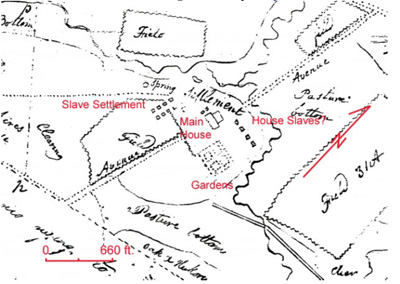
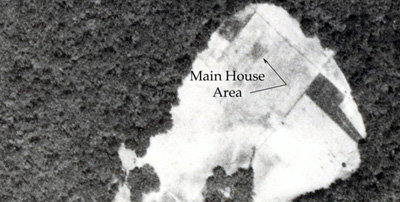
An 1800
plat shows the Waring
settlement. The gardens are
depicted as four quadrants
southeast of the main house.
Shaffer explained that by
1887 the “palatial
residence” was only a “heap
of bricks” and the gardens
had been “cleared and
plowed,” covered “with thick
second growth forest.”
Aerial photographs from 1938
show a stain that was the
main house. All around it
are plowed fields with no
sign of a garden.
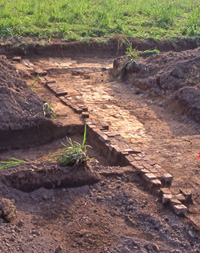 Although
nothing was visible on the
surface, the gardens gave up
at least some of their
secrets to careful
archaeological study.
Soils were studied for
the chemicals they
contained. Archaeologists
found that the
soil pH had been altered
– making the garden less
acidic and more able to
support garden plants.
Another essential plant
nutrient,
phosphate, was also
higher in the Tranquil Hill
garden than elsewhere on the
archaeological site. This
reveals that the owners were
adding compost to their
garden to improve the soil –
just like gardeners today. Although
nothing was visible on the
surface, the gardens gave up
at least some of their
secrets to careful
archaeological study.
Soils were studied for
the chemicals they
contained. Archaeologists
found that the
soil pH had been altered
– making the garden less
acidic and more able to
support garden plants.
Another essential plant
nutrient,
phosphate, was also
higher in the Tranquil Hill
garden than elsewhere on the
archaeological site. This
reveals that the owners were
adding compost to their
garden to improve the soil –
just like gardeners today.
Archaeologists also studied
the
pollen and
phytoliths recovered
from the garden soil. This
work revealed evidence of
plants that might have been
intentionally planted.
Recovered was pollen of
Artemisia, an herb,
accent plant, and medicinal
plant. Also recovered was
pollen of
Liliaceae, a member of
the four o-clock family, and
roses. Pollen of the pink
family was found. Flowers in
the
pink family include
Sweet William and
carnations. Thus,
archaeologists were able to
identify some of the plants
and flowers that were found
in the Tranquil Hill gardens
over 150 years ago!
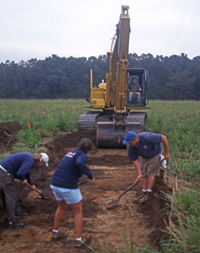 The
gardens gave up additional
mysteries during excavation.
Chicora archaeologists found
the northern edge of the
garden, identified by a
narrow planting bed. This
would have been about 2˝
feet wide at the surface and
about 2 feet in depth. This
is perfect for the planting
of
boxwood or a similar
hedging material. The soils
were dark – indicating that
the soil was amended with
organics. The phytolith
study suggests kitchen
debris and ash were used as
compost. The
gardens gave up additional
mysteries during excavation.
Chicora archaeologists found
the northern edge of the
garden, identified by a
narrow planting bed. This
would have been about 2˝
feet wide at the surface and
about 2 feet in depth. This
is perfect for the planting
of
boxwood or a similar
hedging material. The soils
were dark – indicating that
the soil was amended with
organics. The phytolith
study suggests kitchen
debris and ash were used as
compost.
The one
garden quadrant – or
parterre – measured 220
by 120 feet, or 0.6 acre
(that’s about half of a
football field).
Small
structures were located at
the northeast and northwest
corners of the garden
parterre. One was wood, the
other brick. Both were only
three-sided, with the north
sides open. Both structures
originally measured 15 by 24
feet. These likely
represented what are known
as garden
follies – perhaps arbor
alcoves intended for
meditation.
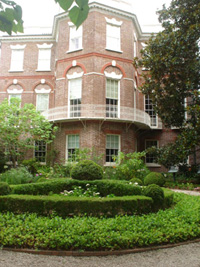 The
archaeology also found
postholes throughout the
garden, as well as what were
likely planting holes.
Artifacts were uncommon –
indicating that the garden
wasn’t used for trash
disposal, but was kept
clean. The
archaeology also found
postholes throughout the
garden, as well as what were
likely planting holes.
Artifacts were uncommon –
indicating that the garden
wasn’t used for trash
disposal, but was kept
clean.
Gardens
didn’t just exist on
plantations – they were a
common feature in urban
settings as well.
Charleston’s wealthy
planters almost always
included a garden on their
townhouse property.
Archaeology is also being
conducted in these
urban settings. One of
the best is The Charleston
Museum’s excavations at the
Nathaniel Russell House
in downtown Charleston,
South Carolina.
Resources
Learn More About the
Archaeology at Tranquil Hill
Other Web Resources
Gunston Hall Plantation
Garden Archaeology
New England Landscape Design
& History Association
Garden Archaeology at the
Wren Yard, College of
William and Mary
Mount Vernon’s Upper Garden
and
Mount Vernon’s Fruit Garden
and Nursery
The Alliance for Historic
Landscape Preservation
South Carolina Historic
Landscape Initiative
Where
to Find Library Books on
Garden Archaeology
Yamin and Metheny,
Landscape Archaeology
Kelson and Most, Earth
Patterns: Essays in
Landscape Archaeology
Noël Hume, Archaeology
and the Colonial Gardener
Miller and Gleason, The
Archaeology of Garden and
Field
Taylor, The Archaeology
of Gardens
Where to Find Library Books
on Historic Garden
Restoration/Preservation
Goulty, Heritage Gardens
Favretti and Favretti,
Landscapes and Gardens for
Historic Buildings
Adams, Restoring American
Gardens
|